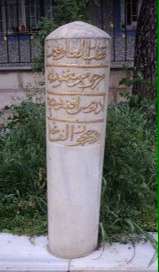Idris Bitlisi
Idris Bitlisi (c. 1455 – 15 November 1520), sometimes spelled Idris Bidlisi, Idris-i Bitlisi, or Idris-i Bidlisi ("Idris of Bitlis"), and fully Mevlana Hakimeddin İdris Mevlana Hüsameddin Ali-ül Bitlisi, was an Ottoman Kurdish religious scholar and administrator from Bitlis (in modern Turkey).[1] There is some controversy about his actual place of birth possibly having been around Diyarbekir (modern Diyarbakır). He wrote a major Ottoman literary work in Persian, named Hasht Bihisht, which began in 1502 and covered the reign of the first eight Ottoman rulers.[2]

Biography
Bitlisi's father, Hosam al-Din Ali Bitlisi, was a Sufi author strongly affiliated to the Sufi Nurbakhshi sect.[3] Like his father, Idris Bitlisi began his career in the Akkoyunlu court, in the service of Yakup Bey, son of Uzun Hasan. He attracted the attention of the Ottoman sultan Selim I and served under him for much of the rest of his life. He joined Selim I in his campaigns against the Mamluks and the Safavids. In 1514 he lead the Kurdish forces who captured of Diyarbakır from the Safavids.[4] Bitlisi also assisted the sultan in establishing an Ottoman administration in Egypt, now the Egypt Eyalet (province) of the Ottoman Empire, after its conquest in 1517. He was appointed to numerous administrative positions of significant responsibility including Kazasker (district supreme administrative judge) of Diyarbekir and Arabia.
Bitlisi was instrumental in the incorporation of the territories of Urfa and Mosul into the Ottoman Empire without a war, and of Mardin after a long siege. He played a key role in driving the Alevi Turkomans from the whole region and the assimilation and Ottomanization of the remaining Sunni Kurds.
He died in Constantinople on 15 November 1520, shortly after the death of his longtime benefactor, Sultan Selim I. Bitlisi was buried in Eyüp neighborhood of Constantinople, in the garden of the complex known as "İdris Köşkü" (Idris House) or "İdris Çeşmesi" (Idris Fountain), built by his wife Zeynep Hatun.
Bitlisi wrote extensively towards the end of his life; his best known work is "Selim Şahname", an epic history of Selim I's reign.
References
- Islamic Encyclopedia
- Bertold Spuler. Persian Historiography & Geography Pustaka Nasional Pte Ltd ISBN 9971774887 p 68
- Yazici 2004, p. 490.
- Özoğlu, Hakan (2004-02-12). Kurdish Notables and the Ottoman State: Evolving Identities, Competing Loyalties, and Shifting Boundaries. SUNY Press. pp. 47–49. ISBN 978-0-7914-5993-5.
External links
Bibliography
- Uğur, Ahmet (1991). İdris-i Bitlisi ve Şükri-i Bitlisi (in Turkish). Kayseri, Turkey: Erciyes Üniversitesi Yayınları. ISBN 978-975-7598-17-6.
- Bayraktar, Mehmet (2006). Kutlu Müderris İdris-i Bitlisi (in Turkish). Istanbul, Turkey: Biyografi Net Yayınları. ISBN 978-975-00394-7-8.
- Kirlangic, Hicabi (2001). Selim Şahname (in Turkish). Ankara, Turkey: Works on Culture Series, Turkish Ministry of Culture. ISBN 975-17-2588-7.
- Yazici, Tahsin (2004). "ḤOSĀM-AL-DIN ʿALI BEDLISI". Encyclopaedia Iranica, Vol. XII, Fasc. 5. p. 490.CS1 maint: ref=harv (link)